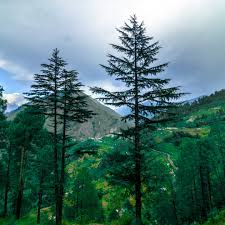Uttarakhand Switch to Hindi
Hundreds Turn Up To Save Trees In Uttarakhand
Why in News?
Recently, hundreds of men, women and children gathered at the holy Jageshwar Dham in Almora district of Uttarakhand to tie raksha sutra (thread for protection) around the region’s famous Himalayan cedar trees (Cedrus Deodara).
Key Points
- Some of the trees are over 500 years old and they surround one of the largest clusters of 125 temples within one complex in the world, situated at 1,870 metres above sea level.
- The raksha sutra was tied around more than 1,000 trees that were to be axed for a road widening project under the State government’s ‘Manas Khand Mandir Mala Mission’ that aims to improve connectivity to about 50 temples in Uttarakhand.
- It is similar to the famous Chipko movement of the 1970s to protect Uttarakhand’s forests from the increasing destruction due to rapid industrialisation.
- This is not the first time that the State government had drawn criticism for its allegedly reckless cutting of trees to aid development in Jageshwar.
- The Uttarakhand High Court in September 2018 had banned all construction activities around the temple site until the government framed building bylaws.
- The HC, taking suo motu cognisance of the “unplanned and unauthorised” construction around the Jageshwar temple complex, also ordered to stop the construction of the Aartola-Jageshwar road.
Cedar Trees
- Cedrus deodara, commonly known as the deodar cedar, is a species of coniferous tree native to the western Himalayas. It is highly valued for its timber and is widely cultivated for its ornamental beauty.
- These trees are adapted to cold climates and are often found at higher elevations.
- They are well-suited to temperate and subalpine climates.
- Deodar Cedars are often used in landscaping and as ornamental trees in parks and gardens due to their attractive, pyramid-shaped growth and aromatic wood.
- They provide habitat and food for various wildlife, including birds and small mammals.
Manaskhand Mandir Mala Mission
- Under the Manaskhand Mandir Mission the government will develop better roads along with better transportation facilities on the routes of the temples.
- Development of hotels and homestay facilities along the routes of the temples keeping in mind the volume of pilgrims visiting these mandir in the next 25 years.
- Under the first phase of the Manaskhand Mandir Mala Mission ,16 identified temples in the Kumaon division will be developed.
- Under the Manaskhand Temple Mala Mission following temples has been identified:
- Jageshwar Mahadev Temple in Almora
- Chitai Golu Temple
- Suryadev Temple Katarmal,
- Kasar Devi Temple
- Nanda Devi Temple
- Patal Bhuvaneshwar Temple in Pithoragarh
- Haat Kalika Temple
- Bagnath Temple in Bageshwar
- Baijnath Temple
- Patal Rudreshwar in Champawat
- Maa Purnagiri Temple
- Maa Barahi Devi Temple
- Baleshwar Temple
- Naina Devi Temple in Nainital
- Kainchi dham Temple and Chaiti Dham Temple in Udham Singh Nagar
Chipko Movement
- It was a non-violent agitation which originated in Uttar Pradesh’s Chamoli district (now Uttarakhand) in 1973.
- The name of the movement ‘chipko’ comes from the word ’embrace’, as the villagers hugged the trees and encircled them to prevent being hacked.
- It is best remembered for the collective mobilisation of women for the cause of preserving forests, which also brought about a change in attitude regarding their own status in society.
- Its biggest victory was making people aware of their rights to forests, and how grassroots activism can influence policy-making regarding ecology and shared natural resources.
- It led to a ban on commercial felling of trees above 30 degrees slope and above 1,000 msl (mean sea level) in 1981.
Haryana Switch to Hindi
Haryana CM Announces Development Projects for Nuh
Why in News?
Recently, Haryana Chief Minister Manohar lal Khattar announced development projects worth approximately Rs 700 crore for Nuh district.
Key Points
- The chief minister also said that all gurukuls and madrasas "opting for modern education" would receive financial assistance upon registration with the Haryana School Education Board.
- Gurukuls and madrasas opting for modern education through the Haryana School Education Board will receive Rs 2 lakh per year for 50-80 children, Rs 3 lakh for 81-100 children, Rs 5 lakh for 101-200 children, and Rs 7 lakh per year for above 200 enrolments.
- This was announced during a state-level function organised in honour of Shaheed Raja Hasan Khan Mewati in Nuh.
- He also unveiled a 15-foot-tall statue of Shaheed Raja Hasan Khan at Government College Nagina on his martyrdom day.
- The chief minister virtually handed out job offers to 1,504 local youth for teaching positions under the Haryana Kaushal Rojgar Nigam (HKRN).
- He also announced the formation of a five-member committee named after Shaheed Hasan Khan Mewati, chaired by former MLA and state Waqf Board Chairman Zakir Hussain, to oversee development projects.
Raja Hasan Khan Mewati
- He was a Muslim Khanzada Rajput ruler of Mewat.
- The son of previous ruler Raja Alawal Khan, his dynasty had ruled Mewat State for nearly 200 years.
- He was a descendant of Raja Nahar Khan Mewati, who was the Wali of Mewat in the 14th century.
Haryana Kaushal Rozgar Nigam Limited
- It has been incorporated under the Companies Act, 2013 on 13th October, 2021.
- It has been set up with the objective of providing contractual manpower to all Government entities in Haryana in a transparent, robust and equitable manner.
- It will act as the authorized agency for providing contractual manpower in Haryana.
- Haryana Kaushal Rozgar Nigam, in the process of providing contractual manpower, will focus on:
- Uplifting socio-economically disadvantaged candidates
- Facilitating timely payment of salary and benefits to deployed manpower
- Ensuring adherence to the State Reservation policy
Central Waqf Council
- It is an Indian statutory body established by the Government of India under the Waqf Act, a subsection of the Waqf Act, 1995.
- It was established for the purpose of advising it on matters pertaining to the working of the State Waqf Boards and proper administration of the Waqfs in the country.
- Waqf is a permanent dedication of movable or immovable properties for religious, pious or charitable purposes as recognized by Muslim Law, given by philanthropists.
Haryana Switch to Hindi
Haryana Proposes Fresh Delineation of Eco-Sensitive Zone
Why in News?
Recently, the Haryana government has proposed that an area of 1,000 metres around the Sukhna Wildlife Sanctuary on the Haryana side be delineated as an Eco-Sensitive Zone (ESZ).
Key Points
- The proposal was sent in January 2024 to the Union ministry of environment, forest and climate change (MoEFCC) for issuing a final notification delineating the eco-sensitive zone on the Haryana side.
- The Sukhna Wildlife Sanctuary, spread over 25.98 square km (about 6420 acres), is under the administrative control of union territory of Chandigarh and shares its boundaries with Haryana and Punjab.
- The protected area, being rich with diverse flora and fauna, contains a variety of topographical features and was declared a wildlife sanctuary in 1988 by the Chandigarh administration.
- As per the draft proposal sent to the MoEFCC:
- The total area of the proposed eco-sensitive zone will be 2,460 hectares (about 6,078 acres).
- 10 villages - Prempura, Sukhomajri, Damala, Lohgarh, Manakpur Thakardas, Surajpur, Chandimandir Kotla, Darra Kharauni, Rampur and Saketri/Mahadevpur fall within the proposed ESZ.
- The state government has proposed to divide the ESZ into four zones:
- The extent of zone 1 will be 100 meters from the boundary of Sukhna wildlife sanctuary.
- Zone 2 will be 100 metres to 300 metres from the boundary of the protected area.
- Zone 3 will comprise of area falling in 300-700 metres from the boundary of the protected area.
- The rest of the area that is 700 to 1,000 metres from the boundary in the protected area shall be in zone 4.
- All activities other than the activities prescribed for conservation and protection of its habitat are prohibited.
- Eco-sensitive zones act as shock absorbers and insulate the protected area from the likely adverse impact of the activities in the adjacent areas.
- In the revised draft the state government has also incorporated the suggestions of Wildlife Institute of India that the eco-sensitive zone be extended till the reserve forest boundary.
Eco Sensitive Zones
- The National Wildlife Action Plan (2002-2016) of the Ministry of Environment, Forest and Climate Change (MoEFCC) stipulated that state governments should declare land falling within 10 km of the boundaries of national parks and wildlife sanctuaries as eco-fragile zones or Eco-Sensitive Zones (ESZs) under the Environmental (Protection) Act, 1986.
- While the 10-km rule is implemented as a general principle, the extent of its application can vary. Areas beyond 10 km can also be notified by the Union government as ESZs, if they hold larger ecologically important “sensitive corridors”.
Sukhna Wildlife Sanctuary
- It is located in Chandigarh.
- It forms the part of Sukhna Lake catchment area falling in Shivalik hills.
- Fauna: Sambar deer, Barking deer, and wild boar, as well as several species of birds, reptiles, and amphibians.
- Flora: The sanctuary is characterized by a mix of forests, grasslands, and wetlands, with the Sukhna Lake forming an important part of the ecosystem.
Madhya Pradesh Switch to Hindi
Madhya Pradesh HC Orders ASI Survey of Bhojshala Complex
Why in News?
Recently, the Madhya Pradesh High Court directed the Archaeological Survey of India (ASI) to conduct a scientific survey of the Bhojshala Temple-Kamal Maula Mosque complex situated in the Dhar district.
Key Points
- The site is an ASI-protected, 11th Century CE monument. Under an agreement with the ASI, puja is performed in the temple by Hindus every Tuesday and Namaz offered every Friday.
- The court has ruled or decided that there is a necessity to clarify or reveal the true essence and identity of the entire monument under the maintenance of the Central government.
- The court concluded that it is the constitutional as well as statutory obligation of the ASI to hold the scientific survey of the site at the earliest under Section 16 the Monument Act, 1958.
- The court asked the ASI to photograph and videograph the survey as well as unlock and open the locked/sealed rooms, halls of the whole complex and prepare a complete inventory of each and every artifact, idol, deity, or any structure found in the said locked, sealed halls, and rooms, and submit the same along with the respective photographs.
- This archaeological site at Dhar also bears ancient inscriptions that attracted the early attention of colonial Indologists, historians and administrators.
- John Malcolm mentioned Dhar in 1822, along with building projects such as the dams planned and completed by King Bhoja.
- Earlier in September 2023, the guards reportedly found an idol of Goddess Vagdevi. However, the administration had denied the claim of the idols ‘appearing’ and removed it.
Archaeological Survey of India (ASI)
- ASI, under the Ministry of Culture, is the premier organization for the archaeological research and protection of the cultural heritage of the nation.
- It administers more than 3650 ancient monuments, archaeological sites and remains of national importance.
- Its activities include carrying out surveys of antiquarian remains, exploration and excavation of archaeological sites, conservation and maintenance of protected monuments etc.
- It was founded in 1861 by Alexander Cunningham- the first Director-General of ASI. Alexander Cunningham is also known as the “Father of Indian Archaeology”.
Bhojshala Complex
- The Bhojshala literally translates from Sanskrit as the ‘Hall of King Bhoja’ is an historic temple located in Dhar, Madhya Pradesh.
- King Bhoja hailed from the Paramara dynasty of central India, and was renowned as a patron of education and the arts, to whom major Sanskrit works on poetics, yoga and architecture are attributed.
- The 11th-century Bhojshala is an ASI-protected monument. Hindus believe it is a temple of Goddess Vagdevi (Saraswati) but the Muslim side disputes it claiming that it is Kamal Maula Mosque.
Note
The Ancient Monuments and Archaeological Sites and Remains (AMASR) Act, 1958 provides for the preservation of ancient and historical monuments, archaeological sites and remains of national importance.
Jharkhand Switch to Hindi
Nitin Gadkari Lays Foundation for Highway Projects
Why in News?
Recently, Union transport and highway minister Nitin Gadkari virtually laid the foundation stones of highway projects worth Rs 2,500 crore.
Key Points
- These projects include the construction of the four-laning of Tupudana to Kundi Bartoli section (including Khunti bypass) and the widening and upgradation of the Bero to Khunti section.
- These projects will save time and fuel, which will reduce pollution. Modern and high-quality roads will ensure easy and safe transportation.
- Economic activities will be encouraged and new opportunities for employment and entrepreneurship will be created.
Uttar Pradesh Switch to Hindi
Uttar Pradesh on Alert After CAA Implemented Across Country
Why in News?
An alert was issued in Uttar Pradesh after the announcement of Citizenship Amendment Act (CAA), 2019 implementation.
Key Points
- The DGP headquarters has ordered officers to remain on alert while additional forces have been deployed in sensitive areas.
- To monitor social media to control content that can instigate the public.
- The police across the state have been instructed to patrol concerned areas on foot.
- CCTV and drone cameras will be deployed to monitor the situation in the state.
- The development came after the Union Home Ministry officially notified the rules for the implementation of the CAA.
Citizenship Amendment Act (CAA), 2019
- The CAA provides citizenship on the basis of religion to six undocumented non-Muslim communities (Hindus, Sikhs, Buddhists, Jains, Parsis and Christians) from Pakistan, Afghanistan and Bangladesh who entered India on or before 31st December, 2014.
- It exempts the members of the six communities from any criminal case under the Foreigners Act, 1946 and the Passport Act, 1920.
- The two Acts specify punishment for entering the country illegally and staying here on expired visas and permits.








%20MPPCS%202025%20Desktop%20E.jpg)
%20MPPCS%202025%20Mobile%20E%20(1).jpg)










.png)
.png)











 PCS Parikshan
PCS Parikshan



